Robbing Screens: Part 8– Do They Work in Concert with Guard Bees
July 1, 2025
Contents
An Unsuccessful Attempt to Create Robbing
Field Observations of the Guards Behind Robbing Screens
How Colonies Guard Themselves against Foreign Bees
The Behavior of Guard Bees
My Conclusions
Next Month
Acknowledgements
Citations and Notes
Robbing Screens Part 8:
Do They Work in Concert with the Guard Bees?
Randy Oliver
ScientificBeekeeping.com
First Published in ABJ February 2025
When we monitor the upper openings of the robbing screens that we’ve tested, we can’t help but notice that there are seldom any guard bees manning those portals to check the IDs of bees attempting to gain entry!
I can’t believe that I’m eight articles into this series! Allow me to begin with an admission: until researching this subject, I’d never used a robbing screen. I began this research solely to answer a question posed to me: Are robbing screens effective at reducing mite immigration? The answer appears to be “no,” but as is common in scientific research, one question leads to another, and that to yet another, and perhaps to discoveries that you never dreamed of.
AN UNSUCCESSFUL ATTEMPT TO CREATE ROBBING
By this time in our experimentation with robbing screens, it was autumn of our second year, and robbing pressure in our home yard was strong. It occurred to me that this was our chance to test whether robbing screens could actually prevent the robbing of weak colonies from occurring. So we ran a small preliminary experiment.
We had a couple of rows of late-season nucs available in my home yard, so we transferred 10 of them (at their original locations) into the centers of single deeps (equalizing them to 4-5 combs of bees), adding drawn comb and capped honey to either side to fill all ten frame positions (thus creating 10 weak colonies having a limited number of bees to guard their desirable honey). We randomly installed three types of robbing screens (2 of each type, plus 4 unscreened Controls), and gave the colonies a few days to get used to their new boxes and robbing screens (Figure 1). During that time, we open fed anise-scented sugar syrup a few times a day between the rows of the test hives. At each feeding, the syrup trays were mobbed by foragers (presumably from another 50 hives sitting nearby), and investigating bees were attracted to the alluring scent of anise anywhere property.
 Fig.1 Our attempt to test whether robbing screens could prevent weak colonies from being robbed out. Corrine and Rose helped me monitor the action at the hive entrances. In the foreground is jug of the scented syrup that we used to stimulate robbing pressure.
Fig.1 Our attempt to test whether robbing screens could prevent weak colonies from being robbed out. Corrine and Rose helped me monitor the action at the hive entrances. In the foreground is jug of the scented syrup that we used to stimulate robbing pressure.
Once the intentionally-weak test hives were settled down, we let the open feeders go dry each day, and increased the robbing pressure on the test hives by providing them with scented sugar syrup via their top feeding holes (sometimes just squirting it in), so that they would be exhausting the odor of the bait syrup out their entrances. This immediately created strong robbing pressure, and we could easily observe defensive behavior and fighting at the Control hive entrances, but not at the screened hives (although some had dead bees on the ground in front of them.
RESULTS: To our great disappointment, not a single hive got overwhelmed by robbers — whether they had a robbing screen on or not. We repeated the feeding and baiting of the test hives for a couple of weeks, but despite their small clusters and fragrant goods inside, danged if we could induce the robbing out of a single one. 🙁
Although I’m quite familiar with watching the high-mite colonies that I bring home for experimental purposes get robbed out in their final stages of collapse, the above result was consistent with what I’ve observed over the years. In my location, it generally takes only a handful of guard bees to prevent robbers from gaining access to even a weak hive containing capped honey (as opposed to those containing open nectar).
A previous observation: It occurred to me that last year I had tried again and again to take an illustrative photo of bees guarding the upper opening of the stainless steel robbing screens that was testing at the time. But I was never able to catch a guard doing so! So I decided to start focusing my attention upon the guard bees.
FIELD OBSERVATIONS OF THE GUARDS BEHIND ROBBING SCREENS
Our previous research showed that when we fitted scent-baited empty hives with robbing screens, some potential robbers eventually found their way in. So why did those weak test hives not get robbed out? We could clearly observe the action of the guard bees at the entrances of the unscreened Control hives, but was that also occurring at the openings of the robbing screens?
So day after day, and in different locations and hives, we closely watched (and filmed) the behavior of the bees at the openings of the different types of robbing screens, as well as at the entrances of Control hives next door.
RESULTS: Contrary to the obvious guarding behavior at the entrances of unprotected Control hives, what my helpers and I observed at the top openings of the three types of robbing screens, is that only occasionally was there any guarding behavior evident at those top openings, or even monitoring of incoming bees by any guards! (Figure 2).
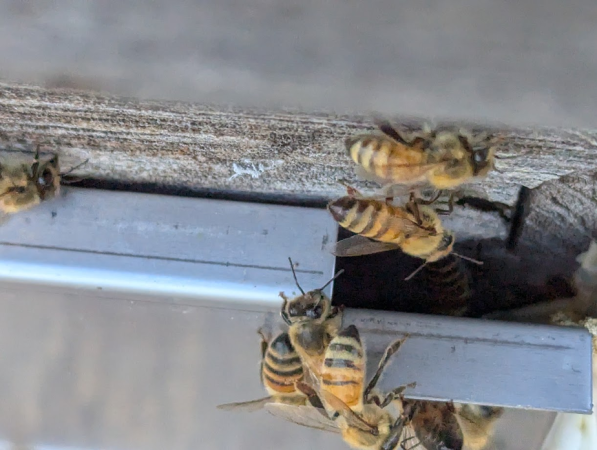
Fig. 2 Note the lack of outward-facing guard bees at this upper opening. Although most of a colony’s foragers eventually learn to use the top openings, it was rare for us to see the faces of any guards facing outward, or any head turning or other response to our waving fingers or a swinging dead bee lure. This strongly suggested that guard bees do not recognize the top opening of a robbing screen as the entrance to their nest cavity.
The lack of guarding behavior at the openings of the robbing screens really surprised us. To further investigate, I cut plastic and stainless steel guards to place black window screen in front of both the top opening and the lower hive entrance, so that we could observe whether incoming bees (either returning foragers or investigating “thieves”) were ever checked by guards (Figure 3).
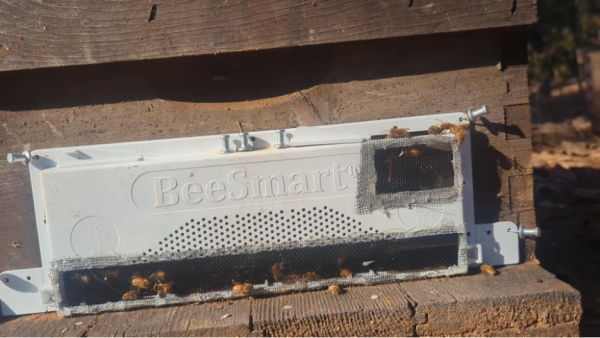
Fig. 3 When I put viewing screens in front of the top openings, we’d only occasionally observe a guard — but even they were generally outside the screens. Only rarely did we observe a guard intercepting any incoming foreign bee inside the top opening. We laid on our bellies day after day when there was plenty of robbing pressure, and watched bee after bee enter the top opening and then just walk down to the lower entrance without ever being checked by a guard.
Practical application: I suspect that the lack of guards at the top openings may be due to the guards not recognizing that remote-from-the-cluster opening (with light coming in between it and the actual nest cavity entrance) as the place to take up their defensive position.I may be making a dumb assumption, but it seems to me that a robbing screen might be even more effective if it were designed to work in conjunction with the colony’s guard bees, and encourage them to set up an inspection station at the robbing screen’s opening. So I dug into the literature to see what I could learn about the behavior of guard bees, and especially what cues trigger them to “activate” and challenge an incoming foreign bee.
HOW COLONIES GUARD THEMSELVES AGAINST FOREIGN BEES
There are any number of critters that would love to gorge on the energy-rich honey stored in a hive, so honey bees have evolved effective defenses against them. A few large predators, such as honey badgers, bears, and humans, require that a colony stores its goods in a strong physical fortress, preferably high above the ground. But most smaller predators or thieves are deterred by the bees’ painful sting. Others, such as ants, are identified by smell, and bitten.
But anywhere that colony density is high, the bees must also protect their honey from theft by foragers from other hives, especially when floral nectar sources dwindle. Hungry foragers will then investigate any scent that they might associate with a sugary reward — especially that of ripening nectar or inadequately guarded honey.
Practical application: A colony’s innate and most effective defense against such potential nectar thieves are its guard bees! So a robbing screen would likely perform best if it was designed to work in concert with the guard bees.
THE BEHAVIOR OF GUARD BEES
In the typical progression of “jobs” that a worker bee performs over the course of its life (“temporal polyethism”), some may act as guards for a day or so (just prior to transitioning to foraging). Bees acting as guards are kinda like “seasonal temps” — a temporary standby force that is only activated if needed (the key word being “activated,” Figure 4).
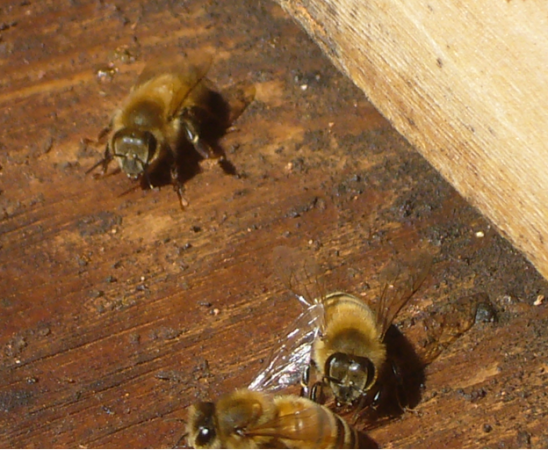
Fig. 4 Activated guard bees assume a typical stance with their front legs raised, and their wings lifted for quick take-off, following any moving object with their heads. The also challenge, “sniff,” and tug at any bee that doesn’t seem “right” to them.
As most beekeepers notice, when a colony is relatively “undisturbed” and there is a nectar flow on, few workers are inclined to act as guards, and even those guards may not be “activated” to any extent.
Practical application: Any beekeeper who doesn’t wear gloves has learned to move smoothly, so as not to “activate” the guards. Any jerky motions of your hands will initiate “warning bumps” from guards flying out to determine whether you are a potential predator, or merely a tree branch waving in the wind.
Younger workers live in darkness and avoid light (being negatively phototactic), and don’t use their sense of sight (if you pull out a comb, the young bees don’t even look at you). The only bees that look at you are those acting as guards that day. Guard bees are extremely observant of anything that moves, being on the lookout for a potential predator or thief.
A guard bee at a hive’s entrance must differentiate a potential thief from the thousands of returning foragers (kinda like an FBI agent trying to pick out a terrorist in an airport lobby). The first cue to alert them is visual notice of unusual movement, which they may then follow with an “identity check and patdown” (sniffing the bee in question for colony scent, and checking to see whether it tries to get away).
Curious foragers from another hive (aka “honey thieves”) exhibit a typical “investigatory” approach to a hive’s entrance while “sniffing” for the source of the attractive scent. Instead of plunging straight into the entrance as do foragers returning home, they wave back and forth a few inches in front of the hive (inspecting for danger, and locating where the odor is coming from). This investigative flight pattern is recognized by the guards and puts them on alert. When an investigating scout tentatively lands, it is generally immediately challenged by one or more guards, and unlike a confused drifted bee, may try to escape.
Butler and Free published a fascinating paper in 1952 titled The behaviour of worker honeybees at the hive entrance [ ]. They describe how colonies generally allow drifted foreign bees who fly “straight in” to peacefully enter the hive — that is, until a number have done so, at which point the guard bees become activated by the scent of “too many” intruders. The authors found that:
Excited guard bees watch the movements of bees flying overhead and approaching the hive, often jerking round to do so, and make intentional movements to intercept any bee which they see alight near them. Each guard tends to patrol a particular, circumscribed, area of the alighting-board, sometimes for an hour or more, then to disappear either within the hive or for a flight only to reappear on guard once more at the same part of the alighting-board [Figure x]. Guard bees intercept and examine members of their own colonies as well as intruders from other colonies, and the guard bees themselves are often in turn approached and examined by other guards of their own colony.
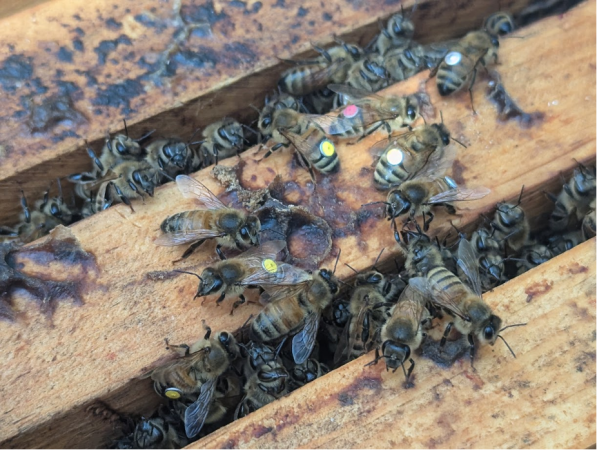
Fig. 5 We also observe guards returning to their exact same station after flight. After gluing steel discs on the backs of guard bees (identified by them facing us with interest) on the top bars, then releasing them to fly back to the hive, a large proportion of them then returned to resume guard duty on the very same top bars that they’d been plucked from several minutes earlier.
Butler and Free continue (boldface mine): It was concluded from the results of these experiments, that provided that a colony of bees has not been disturbed (and its members thus “alerted”), few, if any, guard bees will be present, and foragers from another colony can enter the hive without difficulty or even examination. If, however, the members of the same colony have been “alerted,” some of them commence to guard the entrance, and foragers from another colony are, under these circumstances, liable to be intercepted and examined, although they still enter the hive without hesitation or difficulty.
It is clear from these data that the bobbing motion of a dead-bee lure at the hive entrance was sufficient to alert the experimental colonies, and that guard bees remained in evidence for periods varying from 12-65 minutes, with a mean time of 28.5 minutes.
Again, we’ve confirmed the above, also by using a hanging dead-bee lure for further investigation on many hives in different locales, with or without robbing screens (Figure 6).
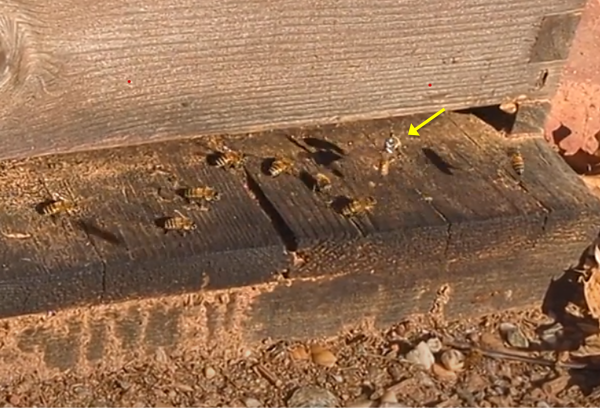
Fig. 6 We swung a suspended dead bee on a fish hook in front of hive entrances to gauge the response of the guards. This is a freeze frame from a video — note how the guard bees have turned to follow the left-to-right motion of the swinging bee indicated by the yellow arrow (the fine leader string doesn’t show ). Activated foragers will often fly out to intercept and attempt to sting the bee lure.
A drifted bee normally walks right into the foreign hive, but if stopped by guards, often offers nectar — which is generally refused. After such refusal the drifted bee my engage in “tongue stropping,” an usual behavior that my placate the guards. But if the guards continue to tug at the legs of the drifted bee, it goes entirely passive and submissive (akin to “playing possum,” aka thanatosis). On the other hand (again from Butler and Free):
When the guards succeeded in seizing a robber the latter invariably tried to break away from them. Occasionally an excited guard was seen to seize a member of her own colony in which case the latter adopted a submissive attitude and was soon released. If a guard bee succeeded in getting a firm hold of a robber she curled the tip of her abdomen towards the robber without any hesitation and attempted to sting her. When this happened the robber and guard bee frequently lay on their sides, holding onto one another’s legs with their mandibles, and, in mutual attempts to sting each other, buzzed round and round extremely fast like a catherine-wheel. Usually in such cases one of the bees succeeded in stinging the other and, on being released, the stung bee crawled away slowly, obviously seriously hurt, and died within 2-3 minutes or less. Sometimes, however, the vanquished bee had such a tight grip on the leg of the victor that the latter had great difficulty in breaking away from the dying bee or even, in some cases, from the corpse. In every one of the many fights that were seen to result in the death of a bee the victorious bee succeeded in withdrawing her sting from the body of her victim extremely quickly.
The steps of action involved in guarding are also described by Napier [ ]:
The mildest defensive behavior is antennation, in which guard bees rub their antennae on returning foragers and use scent cues to determine if the foragers are nestmates or non-nestmate intruders. The next behavior is antennation with open mandibles, a threat behavior. The next behavior is biting, where guards bite the legs, antennae, or abdomen of forager bees. Abdomen flexion is the next most severe behavior, where a guard grabs the forager and flexes her abdomen without extruding her stinger. Stinging is the most severe of the guard behaviors, in which the stinger is extruded in an attempt puncture the cuticle of the other bee. See Figure 7.
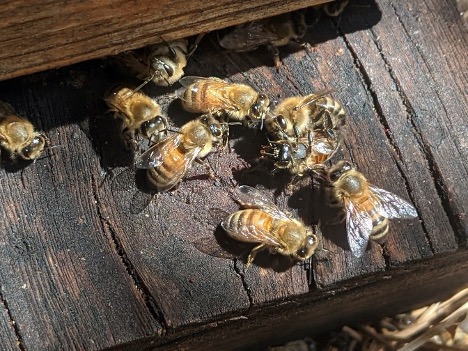
Fig. 7 Guards actively antennating and biting an intruder. One guard is flexing its abdomen in preparation for stinging (note the shininess of the bee being attacked, suggesting that it’s been previously engaged in robbing).
MY CONCLUSIONS
For best functionality, an anti-robbing device would:
(1) Have a small entrance opening where guard bees will be induced to set up a security checkpoint,
(2) That opening placed so that the guards will be visually activated by the flight pattern of investigating potential thieves,
(3) It would be of benefit if the entrance opening location minimized the confusion of returning foragers,
(4) Lastly, its screen would be placed above that entrance to allow the attractive exhaust air to rise and exit there, thus diverting investigating thieves away from the guarded entrance below.
NEXT MONTH
We’ll review the history of robbing screens, and attempt to design an “improved” one that meets the above qualifications, and then test it in the field for performance.
ACKNOWLEDGEMENTS
I thank my helpers Rose Pasetes, Corrine Jones, and Jacob McBride for their many hours of diligent and often tedious field and lab work. And to all you donors who help pay for the cost of our research!
CITATIONS AND NOTES





